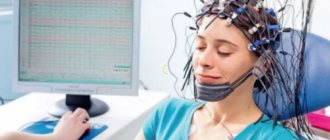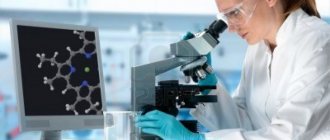Cryptogenic epilepsy is one of the most complex chronic pathologies of the central nervous system, the development of which is due to unknown or uncertain causes. The disease is manifested by regularly recurring specific seizures. The cryptogenic form is found in almost 50% of patients suffering from epileptic seizures.
Cryptogenic epilepsy can be partial, temporal, generalized and focal. With cryptogenic focal epilepsy, patients experience frequent paroxysmal conditions (convulsive seizures). The long course of the disease threatens personality changes, the so-called “epileptic dementia.” This type of pathology is diagnosed mainly at a young age, in patients under 20 years of age, but sometimes occurs in older people. The focal form of cryptogenic epilepsy is practically untreatable, so the patient requires long-term, and most often lifelong, therapy.
What kind of disease is this
Cryptogenic epilepsy has a whole set of epileptic symptoms, the causes of which cannot be determined. The type of illness is hidden. Manifestations of cryptogenic epilepsy are not differentiated from symptoms of other types of disease. With this form, spontaneous electrical impulses occur in the cerebral cortex, causing overexcitation of nerve transmission. As a result, a convulsive focus is formed, provoking an attack.
Seizures can be focal or gradually spreading throughout the victim’s body. The first type of pathology represents limited areas of increased activity in the cerebral cortex.
The symptomatic nature of the disease is detected only with a comprehensive examination of the body. Local abnormalities are detected using magnetic resonance imaging.
Depending on the pathological focus, epilepsy can occur in such lobes as:
- frontal;
- temporal;
- occipital;
- parietal
The frontal form is often accompanied by sudden attacks that last in short series. In rare situations, secondary generalization occurs due to damage to brain cells. If the focus of epileptic activity is localized in the temporal zone, the patient, against the background of regularly manifested emotions, exhibits a phenomenon such as déjà vu. It is this subtype of the disease that is most often encountered in practical medicine. Cryptogenic frontotemporal epilepsy is diagnosed in the same way; the symptoms in this situation are combined.
Pathology is always accompanied by increased activity in the crown area, which is responsible for sensory functions. Victims experience unusual sensory sensations, such as:
- tingling on only one side of the body;
- distorted perception of one's own limbs.
Accompanied by partial seizures, it is the rarest form.
Make an appointment
Reasons for development
To date, it has not been possible to find out why epileptic activity of the cryptogenic type of brain occurs. However, scientists concluded that the development of the disease can be triggered by the following factors:
- burdened heredity;
- complications after traumatic brain injury;
- history of stroke;
- a brain tumor;
- intoxication with chemicals.
The most likely cause of the pathology is considered to be a genetic predisposition.
Symptomatic partial epilepsy
In symptomatic partial forms of epilepsy, structural changes in the cerebral cortex are detected. The reasons that determine their development are diverse and can be represented by two main groups: perinatal and postnatal factors. A history of verified perinatal CNS damage is found in 35% of patients (intrauterine infections, hypoxia, ectomesodermal dysplasia, cortical dysplasia, birth trauma, etc.). Among postnatal factors, neuroinfections, traumatic brain injuries, and tumors of the cerebral cortex should be noted. The onset of seizures in symptomatic partial epilepsy varies over a wide age range, with a maximum in preschool age. These cases are characterized by changes in the neurological status, often in combination with a decrease in intelligence; the appearance of regional patterns on the EEG, resistance of attacks to AEDs and the possibility of surgical treatment. There are symptomatic partial forms of epilepsy: temporal, frontal, parietal and occipital. The first two are the most common and account for up to 80% of all cases.
First signs
The main symptom of epilepsy is seizures. With cryptogenic epilepsy, generalized or partial seizures may occur. Before the onset of partial seizures, more typical of cryptogenic epilepsy, a so-called aura occurs. It signals that a seizure is about to occur. The appearance of the aura allows the doctor to determine the location of the brain lesion.
A motor type aura is accompanied by unexpected movements of the patient, which indicates the location of the affected part in the frontal lobe of the brain. With a rapid deterioration in visual and auditory functions, it can be assumed that the localization of the disorders is in the occipital or temporal lobe.
Expert opinion
Author: Polina Yuryevna Vakhromeeva
Neurologist
In recent years, doctors have noted an increase in the incidence of epilepsy. The exact causes of this disease have not yet been established. It is known that about 4-10 people per 1000 people suffer from seizures. Drug-resistant cryptogenic epilepsy is considered one of the most severe forms of the disease. It is difficult to select treatment for this species due to drug resistance.
A qualified team of doctors at the Yusupov Hospital takes on complex cases. Diagnosis of epilepsy in our clinic is carried out using modern medical equipment. European CT, MRI and EEG equipment are used for examination. They allow you to determine the location of the pathological focus with high accuracy. An analysis of blood and the degree of resistance of the body to drugs is carried out in a modern laboratory.
Therapy for cryptogenic epilepsy is carefully developed by experienced neurologists and epileptologists. In this case, an individual approach is used. Drugs are selected taking into account the degree of drug resistance and other associated conditions. The prescribed medications meet the latest European standards for the treatment of epilepsy.
Read also
Alcoholic epilepsy
In accordance with the International Statistical Classification of Diseases developed by the World Health Organization, alcoholism is considered a “dependence syndrome” and is included in the section of behavioral,…
Read more
Epilepsy and pregnancy
Managing patients with epilepsy and pregnancy is incredibly complex and challenging. What are the features of pregnancy in patients with epilepsy? In 1-2% of cases there is a chance of developing epileptic...
More details
Treatment of epilepsy in Samara
Epilepsy therapy is a long process and requires interaction between the epileptologist and the patient. Currently, it is possible to stop attacks and achieve remission in 60%! How to do it? Basic…
More details
Temporal lobe epilepsy
Temporal lobe epilepsy is a special form of epilepsy, which is characterized by the localization of the epileptic focus in the temporal region of the brain. This type of pathological process is one of the most…
More details
Symptoms of epilepsy
How does epilepsy manifest? The most “famous” epileptic attack is a convulsive one, as the most “bright” one, this attack includes general tonic-clonic seizures, blueness of the face, salivation, ...
More details
Symptoms
The clinical picture of cryptogenic epilepsy is manifested by the following symptoms:
- a more severe course of attacks, in contrast to the classic type of disease;
- reduced effectiveness of drug treatment;
- significantly accelerated pace of personality change;
- different results of diagnostic studies with each subsequent execution.
Each type of cryptogenic epilepsy has its own characteristic features and symptomatic manifestations that make it possible to differentiate one form from another.
Partial seizures characteristic of cryptogenic focal epilepsy can be simple (without loss of consciousness), complex (with loss of consciousness) and complicated by secondary generalized seizures.
The leading symptom complex of cryptogenic focal epilepsy is repeated partial paroxysm.
The nature of simple partial seizures can be motor, sensory, autonomic, somatosensory, accompanied by auditory, visual, olfactory or gustatory hallucinations and mental disorders.
Complex partial seizures in cryptogenic focal epilepsy in rare cases begin with a simple seizure, after which the patient’s consciousness is impaired, and sometimes automatisms occur. After an attack, patients experience confusion. Secondary generalization of partial seizures is allowed. In these cases, at the beginning, an epileptic attack can be simple or complex, and as it develops, there is a diffuse spread of excitation to other parts of the cerebral cortex, after which the paroxysm becomes generalized.
With symptomatic epilepsy, in addition to seizures, other symptoms develop, corresponding to the main lesion of the cerebral cortex. In patients with this diagnosis, intelligence decreases, cognitive impairment occurs, and children experience delayed mental development.
In idiopathic epilepsy, which is characterized by benignity, neurological deficits and mental and intellectual disorders are not observed.
In addition, the disease may be accompanied by the occurrence of twilight states, in which the following occurs:
- auditory and visual hallucinations;
- erratic motor and speech activity;
- clouding of reason.
Attacks of focal cryptogenic epilepsy in adults are more severe than in children. Finding effective therapy is also more difficult for them. Conventional antiepileptic drugs for this pathology have less effect and have virtually no effect in minimal dosages. During the period between attacks, patients continue to have nonspecific symptoms not associated with convulsive attacks: depression, resentment, unreasonable temper, memory impairment.
Signs and symptoms of cryptogenic epilepsy
Seizures are the main clinical manifestations of epilepsy. With West syndrome, the first manifestations of epilepsy can be recorded in the first year of a child’s life. Convulsions appear after the child wakes up, and have their own characteristic features. There is a contraction of the muscles of the neck and head on both sides, making a sort of “nodding movement” called “Saalam spasms.”
With Lennox-Gastaut syndrome, seizures are observed from 2 years of age. Manifestations of this syndrome are more often recorded in boys. Seizures have characteristic symptoms. Tonic convulsions occur with vegetative-vascular reactions (heartbeat increases, shortness of breath and redness appear). Due to loss of tone, the child falls and muscle twitching occurs.
Absence is a non-convulsive epileptic seizure that is not accompanied by loss of consciousness.
Diagnostics
When diagnosing the disease, the main criterion is to exclude organic brain damage. It is for this purpose that the following procedures are used:
- collection of family and individual anamnesis with clarification of the presence of brain injury, birth or congenital pathology;
- electroencephalogram, based on recording the biorhythms of the brain during various activities, for example, sleep, intellectual or physical activity;
- conducting magnetic resonance imaging, which helps detect impaired brain activity or localized brain damage;
- performing angiography, which allows you to study how well the blood supply to the brain flows;
- neuropsychological diagnostics, designed to study the quality of mental activity;
- a blood serum test aimed at detecting syphilis and other pathogenic microorganisms in the body.
The victim must undergo laboratory tests, including genetic diagnostics, biochemical and general blood tests, as well as a urine test. Epilepsy is diagnosed by doctors only after conducting a full range of examinations and excluding the possibility of other pathologies affecting the body.
Varieties
Cryptogenic epilepsy (ICD class 10) is divided into subtypes of varying prevalence. Victims may experience multiple types of seizures, and some medical researchers view the pathology as an intermediate diagnosis requiring the use of additional diagnostic methods.
West syndrome
This variant appears in children aged 2-4 months. The main symptom of this type of neuropsychiatric disorder is spontaneous attacks that quickly arise and cease. The disease causes a child to lag in intellectual development.
When the victim reaches the age of 12 months, the disease may stop on its own or change into another type, for example, Lennox syndrome, which is accompanied by various types of seizures.
Lennox-Gastaut syndrome
This type of pathology refers to the childhood form of epilepsy, which develops in a child between the ages of 2 and 8 years. The syndrome forms independently, less often transforms from a condition that occurs at an earlier age. Characterized by a sudden loss of balance or coordination, and short-term hearing loss. The patient practically does not lose consciousness. Frequent seizures can cause delays in intellectual development and also increase the likelihood of injury.
Myoclonic-astatic form
The form can be diagnosed in children aged 5 months to 5 years. The main symptom that occurs at a very early age is a generalized seizure. Children who can walk experience episodes of loss of balance and coordination.
A seizure consists of lightning-fast and sudden movements of the limbs, rapid nodding of the head, as well as the feeling of a blow to the knee area. Most often, the attack occurs in the morning, after getting up.
Myoclonic absence seizures
A type of disease is detected in the age group from 1 to 12 years. These seizures are the first type of seizure in most situations. By the time an attack is detected, more than half of children have severe mental and intellectual development delays.
The disease is often accompanied by complete or partial loss of consciousness, sudden movements of the muscles of the shoulder girdle, limbs or face with a transition to sudden short-term seizures. The duration of one episode is less than a minute, but can occur several times a day.
Partial seizures
There are several types of partial attacks, these include:
- Motor. Accompanied by cramps and contraction of muscle tissue in certain areas of the body. It occurs and goes away suddenly, without loss or clouding of consciousness.
- Sensory. Characterized by a sudden onset of fever, chills, tingling, burning or crawling sensations. Additionally, there is a disturbance in the functioning of the senses in the form of hallucinations.
- Mental. Characterized by a sudden disturbance in mental or speech activity, loss of balance or coordination, and hallucinations.
- Vegetative. Features include increased sweating, changes in body temperature in certain areas of the skin, increased or slowed heart rate.
Visceral and autonomic seizures
The form occurs in the form of painful sensations in the head and throat. In some cases, adolescents and adults may experience an unreasonable erection or orgasm. The disorder is accompanied by a failure of temperature regulation and surges in blood pressure. Often visceral and autonomic seizures are mixed. Both varieties have a number of features:
- the duration of the attack is 5-10 minutes;
- convulsive muscle contractions are present;
- there are no provoking factors;
- may be combined with other forms of seizures;
- after the seizure stops, a feeling of disorientation in space may occur.
Situational seizures
Several factors can trigger a seizure:
- taking narcotic drugs;
- alcohol consumption;
- use of medications;
- a history of brain injury;
- intoxication with chemicals;
- viral blood infection;
- disruption of the heart or liver.
These attacks can be caused by:
- sudden exposure to bright light, especially flashing light;
- loud sounds;
- temperature changes from extremely high to extremely low.
The above factors can trigger the underlying mechanism for the occurrence of epileptic seizures.
Diagnosis and treatment of epilepsy: opportunities and difficulties
O.V. GLOBA , Candidate of Medical Sciences, Senior Researcher, L.M. KUZENKOVA , Doctor of Medical Sciences, Professor, A.A. BARANOV , Academician of the Russian Academy of Medical Sciences, Doctor of Medical Sciences , Professor, Scientific Center for Children's Education of the Russian Academy of Medical Sciences, Moscow
Paroxysmal conditions, having both an epileptic and non-epileptic nature, are very common in childhood. However, in some cases it can be difficult to differentiate them, since some types of paroxysms have a similar clinical picture. This causes the following problems: delayed prescription of anticonvulsant therapy for epilepsy, which worsens the prognosis of the disease, or unjustified prescription of anticonvulsants to children with paroxysmal conditions of a non-epileptic nature.
Therefore, any paroxysmal disorder requires a comprehensive examination and dynamic monitoring of patients to decide on the prescription of therapy. Sometimes epilepsy is disguised under other diagnoses: “episyndrome”, “convulsive syndrome” or “convulsive readiness”. Such patients, even receiving anticonvulsants for a long time, are confident that they do not have epilepsy. Very often this leads to the choice of inadequate therapeutic tactics.
Epilepsy is one of the most common manifestations of nervous system pathology. This disease has been known to mankind since ancient times. Mention of it is found both in ancient Greek myths and in the Bible. In ancient times, external manifestations of epilepsy caused sacred horror among eyewitnesses. Sometimes people with epilepsy were considered saints, but more often they were associated with otherworldly dark forces. Echoes of these ideas are still alive in our time, so not every person can admit that they have epilepsy. Among children under 15 years of age, epilepsy occurs in 5-10 cases out of 1000, and in some regions it reaches 1% [1, 2]. In approximately 75% of cases, the onset of epilepsy occurs in childhood.
Epilepsy in childhood is characterized by a large number of treatment-resistant forms and polymorphism of seizures
For many decades, epilepsy was considered a single disease, but currently the concept of it has changed significantly. Now epilepsy is considered as a group of diseases that have their own electroclinical characteristics, approaches to therapy and differing prognoses.
Epilepsy (from the Latin epilepsia - grasping) is a heterogeneous group of chronic diseases characterized by recurring episodes of uncontrolled excitation of brain neurons from time to time, which is manifested by repeated unprovoked (with the exception of reflex forms of epilepsy) attacks of disturbances in motor, sensory, autonomic, mental or mental functions. Those. epilepsy is characterized by repeated convulsive or non-convulsive seizures, caused by partial or generalized epileptic discharges of the brain.
The diagnosis of epilepsy is made only if the child has had 2 or more epileptic seizures that occurred without clear provoking factors.
The manifestations of epilepsy are varied, which made it difficult to accept a single classification. The development of electroencephalography methods and their introduction into widespread clinical practice made it possible to compare electrophysiological and clinical signs of epileptic paroxysms. Based on this, in 1981 in Kyoto, the International League Against Epilepsy developed the International Classification of Epileptic Seizures. The classification was based on a principle that takes into account the degree of involvement of the cerebral hemispheres in the development of paroxysm. There are partial (focal, localization-related) and generalized seizures.
In generalized attacks, initial clinical and electroencephalographic manifestations indicate involvement of both hemispheres of the brain in the pathological process. In most cases, they are characterized by loss of consciousness. In partial seizures, the initial clinical and electrophysiological manifestations indicate the involvement of one or more areas of one hemisphere of the brain in the pathological process. There are simple partial seizures, which occur with preserved consciousness, and complex partial seizures, characterized by its disturbance.
During partial attacks, various motor phenomena, sensory (tingling sensation, short-term tinnitus, sensation of smell, taste, short-term loss of vision, flashes of light, etc.) and autonomic reactions can be observed. Over time, as knowledge about these conditions accumulated, it became clear that epilepsies represent a heterogeneous group of epileptic syndromes that differ from each other in etiology, seizure pattern, course and prognosis (Dreifuss, 1994). The same type of seizure may occur in different epilepsies, and some epilepsies may involve more than one type of seizure. In this regard, in 1989 it was developed
International classification of epilepsies and epileptic syndromes, which was based on the etiology, age of onset and nature of paroxysms, that is, the syndromic principle. All epilepsies were divided into idiopathic, symptomatic, cryptogenic and situationally determined: - In idiopathic epilepsies, neuroimaging in most cases does not reveal structural damage to the brain; genes have been mapped for many diseases. — Symptomatic epilepsy is characterized by the occurrence of paroxysms against the background of anatomical damage or known biochemical disorders (for example, epilepsy against the background of brain abnormalities, hereditary metabolic diseases (phenylketonuria, homocystinuria), post-stroke, post-traumatic). — In cryptogenic epilepsies, it is not possible to identify a clear focus during neuroimaging, but the nature of the attacks, the age of onset, and the development of the disease do not allow this condition to be attributed to any of the idiopathic epilepsies. — Situation-related seizures are pathological reactions of a generally normal brain to physiological stress or transient epileptogenic stress. Such conditions include, for example, febrile convulsions that occur during fever and are not a manifestation of neuroinfection.
There are a significant number of factors contributing to the occurrence of epilepsy - hereditary, multifactorial (a combination of hereditary and acquired factors), as well as brain damage in symptomatic forms of epilepsy due to: - hypoxic-ischemic brain damage; — congenital developmental anomalies; - intrauterine infections; — chromosomal syndromes; - hereditary metabolic diseases (aminoacidopathy, organic acid metabolism disorders, pyridoxine-dependent seizures); - birth damage to the central nervous system; - infections of the nervous system; - traumatic brain injury; - tumors; - intracerebral hemorrhages; — withdrawal syndrome; - metabolic disorders (transient, prolonged hypoglycemia, associated with congenital metabolic disorders, hypocalcemia, accompanied by DiGeorge syndrome, hypomagnesemia, bilirubin intoxication).
The diagnosis of epilepsy is clinical and electroneuroimaging [3]. In this regard, to make a diagnosis, it is necessary to have not only a clinical description of the attacks, but also electroencephalographic confirmation using routine EEG recording, EEG video monitoring, and, if necessary, long-term EEG video monitoring; neuroimaging methods (CT, MRI, high-resolution MRI, possibly with SPECT, functional MRI); molecular genetic research methods; differential diagnosis with hereditary metabolic diseases for the implementation of etiotropic therapy, if possible. Epilepsy, especially with resistant seizures, is a common manifestation of certain chromosomal diseases and hereditary metabolic diseases. Since the creation of the last classification, a large number of new epileptic syndromes have been described and some provisions of the classification have been revised.
In this regard, in 2001, the International Commission on Classification and Terminology released a draft new classification of epileptic seizures and epileptic syndromes [4]. It presents childhood epileptic encephalopathies: severe behavioral, cognitive or motor disturbances that occur in children due to frequent epileptic seizures and/or prolonged, usually diffuse, interictal epileptiform discharges on the EEG (Guerrini, et al., 2002), as well as reflex seizures and reflex epilepsy. However, the classification continues to improve.
In childhood, the adverse effect of epileptic seizures on the cognitive functions of the brain and the direct damaging effect on nervous tissue are manifested: there is a direct relationship between the severity and distribution of changes in nerve cells and the severity of the attacks; Particularly severe consequences occur in the brain during polymorphic convulsive seizures and partial seizures with secondary generalization
Recently, paroxysmal states of epileptic origin have been actively studied. The introduction into practice of high-tech methods of examination and studying the pathogenesis of paroxysmal disorders allows expanding the diagnostic and therapeutic capabilities of controlling these conditions (Dulak O., Chiron K., 2006; Karlov V.A., 2002; Mukhin K.Yu. et al., 2004 ).
Timely establishment of the correct diagnosis—a specific form of epilepsy—is of fundamental importance, since the treatment strategy and prognosis of the course of the disease depend on it. The diagnosis must be made by an epileptologist.
When treating epilepsy, it is necessary to achieve complete relief of epileptic seizures, as well as prevent their development with minimal side effects of anticonvulsant therapy. If this goal cannot be achieved, it is necessary to reduce the frequency of attacks and/or the severity of clinical manifestations as much as possible, and also ensure that the patient is correctly diagnosed.
To treat epilepsy, antiepileptic drugs are used that can stop and prevent the development of seizures.
The presence of repeated, stereotypical, spontaneously occurring seizures is the main condition for prescribing anticonvulsant therapy.
The main principles of treatment are: - compliance of the drug with the type of seizures and form of epilepsy; - monotherapy, i.e. use of one drug. If ineffective, switch to monotherapy with a second-line drug, and only after that the use of two or more drugs; — sufficient therapeutic dosage with control of the concentration of the anticonvulsant in the blood; — starting therapy with a minimum dose of an anticonvulsant drug and agreeing on all changes in therapy with the attending physician; — regularity; — duration (at least 3 years); - individual approach.
It must be remembered that inconsistency of the drug with the nature of the attacks or syndrome can lead to an increase in paroxysms and a deterioration in the child’s condition.
Epilepsy is a disease that requires long-term treatment (at least 3 years after the cessation of attacks). With properly selected therapy, it is possible to achieve adequate control of attacks in 70% of patients. Due to the presence of epileptic syndromes in childhood that are difficult to treat, the use of anticonvulsants in children has its own characteristics.
Epilepsy is a disease that requires long-term treatment (at least 3 years after the cessation of attacks). With properly selected therapy, it is possible to achieve adequate control of attacks in 70% of patients
Having chosen a drug, it is necessary to develop an optimal dosage regimen, which is determined by the pharmacokinetics of the drug, its toxicity and release form. The administration of liquid forms (solutions, suspensions) and suppositories allows you to quickly achieve the required concentration of the drug in the blood plasma, but requires multiple doses during the day. The use of prolonged-release drugs or so-called controlled-release drugs (retarded forms) is one of the rational and effective approaches, as it allows to smooth out peaks in plasma concentrations, reduce the risk of side effects and increase the effectiveness of treatment.
The anticonvulsants used differ in their mechanism of action, pharmacokinetics, and effect on the types of seizures and epileptic syndromes.
Let's consider the main drugs used in pediatric practice for the treatment of epilepsy.
Valproic acid and its derivatives: sodium valproate, calcium valproate, magnesium valproate
The mechanism of action of valproates is multifaceted and includes an effect on various parts of the pathogenesis of epilepsy, and is also associated with increased GABAergic inhibition, a decrease in paroxysmal neuronal discharges (blockade of T-type sodium and calcium channels), inhibition of GABA aminotransferase, as well as a decrease in GABA reuptake in the brain . Indications. Valproate is highly effective for all types of epilepsy and epileptic seizures. They are used to treat all forms of epilepsy and epileptic seizures (generalized, partial, and difficult to differentiate seizures), as well as specific syndromes (West, Lennox-Gastaut) and bipolar affective disorder. Valproate is used from the age of 6 months. Iminostilbenes
Carbamazepine
It has antiepileptic, analgesic, antidepressant and normothymic effects. The antiepileptic effect is mainly due to the effect on voltage-dependent sodium channels. The mechanism of action is due to the blockade of voltage-gated fast sodium channels, which leads to stabilization of the neuronal membrane, inhibition of the occurrence of serial neuronal discharges and a decrease in synaptic conduction of impulses. Carbamazepine reduces the release of the excitatory neurotransmitter amino acid glutamate, increases the reduced seizure threshold, increases conductivity for K+, modulates voltage-gated calcium channels, thereby reducing the risk of developing an epileptic seizure. The drug also corrects epileptic personality changes and, ultimately, increases the sociability of patients and promotes their social rehabilitation.
Indications. Carbamazepine is used to treat focal seizures with or without secondary generalization and primary generalized tonic-clonic (but not other generalized) seizures.
Oxcarbazepine
Structurally and in terms of the mechanism of action, it is close to carbamazepine, retains all its positive qualities, but, thanks to changes in the chemical formula, it has a number of additional advantages, mainly due to a significant reduction in side effects and a partially different spectrum of effectiveness. The drug stabilizes pre- and postsynaptic membranes by blocking sodium channels, blocks aspartate-activated transmembrane currents of sodium and calcium, calcium channels, inhibits serial discharges of neurons and reduces synaptic conduction.
Indications. Oxcarbazepine is used to treat simple focal, focal with impaired consciousness, secondary generalized, and primary generalized tonic-clonic seizures. In most cases, the drug is effective in monotherapy of focal seizures (60–85%), which corresponds to the “gold standard” for the treatment of epilepsy. If necessary, it is combined with other drugs of first and second choice - sodium valproate, lamotrigine, levetiracetam, showing good pharmacodynamic properties.
The administration of oxcarbazepine is ineffective and is not recommended for absence seizures, myoclonic, atonic-astatic seizures, childhood epilepsy with centrotemporal seizures (Rolandic epilepsy), Landau-Kleffner epileptic aphasia due to a possible increase in seizure frequency.
Benzodiazepines
Clonazepam
It is a 1,4-benzodiazepine and a chlorinated derivative of nitrazepam. The mechanism of action is associated with increased GABAergic inhibition at the level of GABA (subtype A) receptors. Indications. Clonazepam is used for initial or additional therapy for atypical absences, atonic, myoclonic seizures. However, as a rule, it is not a drug of choice due to side effects and possible addiction. The drug has antiepileptic, anxiolytic, muscle relaxant and hypnotic effects. Clonazepam can be used from the neonatal period.
Hydantoins
Phenytoin
The mechanism of action of phenytoin is associated with a decrease in paroxysmal discharges of neurons (blockade of sodium channels).
Indications. Phenytoin is used to treat all forms of seizures (tonic-clonic, partial and neonatal seizures), with the exception of absence seizures. In newborns, it may increase myoclonus. The drug is relatively effective, but is not the first choice due to fairly pronounced side effects and nonlinear pharmacokinetics. It is used to relieve status epilepticus and prevent epileptic paroxysms after traumatic brain injury and neurosurgical operations. Phenytoin can be used from the neonatal period.
Barbiturates
Phenobarbital
The mechanism of action is due to the enhancement and/or imitation of the inhibitory effects of GABA, disruption of the permeability of cell membranes, and an increase in the threshold of electrical stimulation of the motor zone of the cerebral cortex.
Indications. Phenobarbital is used to treat all types of seizures except absence seizures; hyperbilirubinemia (including in newborns, with chronic intrahepatic cholestasis, congenital non-hemolytic unconjugated hyperbilirubinemia), neonatal seizures. The drug has antiepileptic, sedative, hypnotic and muscle relaxant effects. Phenobarbital can be used from the neonatal period, but is rarely used in widespread practice due to its negative impact on cognitive function.
Succinamides
Ethosuximide
The mechanism of action of ethosuximide is associated with inhibition of nerve transmission in the motor area of the cerebral cortex and blocking of T-type calcium channels in the thalamus.
Indications. Ethosuximide is used for typical and atypical absence seizures in idiopathic and cryptogenic forms of epilepsy. In monotherapy mode, it is used for the treatment of absence seizures in epilepsy in children without generalized epileptic seizures, in combination therapy (as an additional drug) - for the relief of absence seizures in children with generalized seizures, absence seizures in juvenile epilepsy, juvenile myoclonic epilepsy, myoclonic epilepsy with absence seizures, epilepsy with myoclonic absence seizures, epilepsy with myoclonic-astatic seizures. For Lennox-Gastaut syndrome, ethosuximide can be used from the neonatal period.
Other anticonvulsants
Lamotrigine
Has a wide spectrum of action. Effective for Lennox-Gastaut syndrome. It has a beneficial effect on cognitive functions, mood and behavior of patients. Lamotrigine is most appropriately prescribed for the treatment of pregnant women suffering from epilepsy. The antiepileptic effect of the drug is due to the fact that it is an antagonist of glutamate receptors and also affects voltage-dependent sodium channels.
Indications. Lamotrigine is used for monotherapy and adjunctive therapy of partial and generalized seizures (including simple and complex partial, secondary generalized, primary generalized and absence seizures). In pediatric practice, it is not recommended to carry out monotherapy with the drug as an initial treatment method in patients newly diagnosed. Lamotrigine is used from 2 years of age.
Vigabatrin
Irreversible selective inhibitor of GABA aminotransferase. Increases the content of the main inhibitory transmitter of the nervous system, GABA, in synapses, thereby increasing the inhibitory effects. Suppresses the increased excitability of neurons, which underlies the occurrence and spread of epileptic seizures.
Indications. The drug is indicated for partial seizures. Vigabatrin is most effective for the treatment of infantile spasms, especially in combination with tuberous sclerosis. Topiramate
A new anticonvulsant with a unique structure – a sulfamate-substituted monosaccharide. The antiepileptic effect is due to the effect on voltage-dependent sodium channels. Reduces the frequency of action potentials characteristic of a neuron in a state of persistent depolarization, which indicates the dependence of the blocking effect of topiramate on sodium channels on the state of the neuron, modulates GABA and glutamate receptors (AMPA) by inhibiting carbonic anhydrase isoenzymes.
Indications. Topiramate is used to treat adults and children with partial or generalized tonic-clonic seizures, either alone or in combination with other anticonvulsants, and as an adjunctive therapy for the relief of seizures associated with Lennox-Gastaut syndrome. Has a neuroprotective effect. The drug is used from 2 years of age. The disadvantages of the drug include the need for slow titration of the dose (for children - no faster than 1 mg per kg of body weight per week).
Levetiracetam
A new antiepileptic drug. It was synthesized in the process of researching and improving the properties of the nootropic piracetam (nootropil). The structural similarity to piracetam explains the difference in the spectrum of action of levetiracetam and other new anticonvulsants.
Levetiracetam is highly effective, including in pharmacoresistant epilepsy, is well tolerated, has a wide spectrum of action and a favorable pharmacokinetic profile: high bioavailability, low plasma protein binding (less than 10%), linear pharmacokinetics, lack of stimulation of microsomal liver enzymes, half-life of about 8 hours, and therefore it can be used twice a day (Arroyo S., 2002; Muralidharan A., 2006).
Affects various parts of the pathogenesis of epilepsy, including sodium and calcium channels, the GABAergic system. It has fundamentally new mechanisms of action. The drug has been proven to bind to the glycoprotein of synaptic vesicles SV2A, contained in the gray matter of the brain and spinal cord. It is believed that in this way an anticonvulsant effect is realized, which is expressed in counteracting the hypersynchronization of neural activity. In a study of brain changes during experimental occlusion of the middle cerebral artery, it was shown that levetiracetam reduces the volume of infarction by a third, which is due to its neuroprotection against the excitotoxic effect of activation of NMDA receptors in the ischemic zone (Hanon E., 2001).
Levetiracetam is highly effective in the treatment of epilepsy, has a wide spectrum of action and is characterized by an almost complete absence of serious side effects (Hovinga CA, 2001; Arroyo S., 2002). It does not interact with all known anticonvulsants, which eliminates changes in the concentration of the second drug and provides ample opportunities for combination therapy.
Indications. Levetiracetam is used for the treatment of partial seizures with or without secondary generalization in adults and adolescents over 16 years of age with newly diagnosed epilepsy as monotherapy (first choice).
As part of complex therapy, it is used in the treatment of the following conditions: - partial seizures with or without secondary generalization in adults and children over 4 years of age suffering from epilepsy; - myoclonic seizures in adults and adolescents over 12 years of age suffering from juvenile myoclonic epilepsy; - primary generalized convulsive (tonic-clonic) seizures in adults and adolescents over 12 years of age suffering from idiopathic generalized epilepsy.
As an additional therapy, it is prescribed to patients with partial seizures, both with and without secondary generalization. The drug can be used in children over 12 years of age. According to Mukhin K.Yu. et al., levetiracetam is effective in monotherapy of various types of epilepsy, but it can also be used for severe cognitive disorders associated with epileptic activity: Landau-Kleffner epileptic aphasia and epilepsy with constant complexes (spike-slow wave in slow-wave sleep). These syndromes occur between the ages of 2 and 10 years and, if diagnosed untimely or improperly treated, lead to severe neuropsychological defects, sometimes to lifelong aphasia (Landau-Kleffner syndrome). Hoppen T. (2003) showed an improvement in speech and cognitive functions when prescribing levetiracetam to this group of patients.
Achieving drug remission in epilepsy is especially important in childhood due to the fact that often a long course of epilepsy in children leads to the development of epileptic encephalopathy, which adversely affects the mental development of children, causing secondary disability
The drug is also successfully used as an adjunctive therapy in the treatment of epileptic encephalopathies of infancy (Conry JA, 2004; Hmaimess et al., 2006; Lawlor KM, 2005). Unfortunately, levetiracetam is not registered in Russia for use in young children. But, using foreign experience in using this drug, we must strive to reduce the age of its use in our country.
Levetiracetam does not interact with other anticonvulsants and has linear kinetics, and therefore determination of its concentration in the blood is not necessary. Making a diagnosis and selecting adequate therapy for epilepsy is difficult. In this regard, further study of this disease is necessary, which will allow us to develop new treatment regimens and reduce the level of disability. Literature
1. Aicardi J. Epilepsy in children. – NY-Ph, USA: Lippincott-Raven Publshers, 1996.—555 p. 2. Panayiotopoulos CP A practical guide to childhood epilepsy.-2006. – UK: Medicina.—230 p. 3. Mukhin K.Yu., Petrukhin A.S., Mironov B.V. Epileptic syndromes. Diagnostics and therapy. – M.: System Solutions LLC, 2008.—224 p. 4. Epilepsia.—2001.—V. 42, No. 6.—P. 796-780.
Treatment
Timely diagnosis of the disease will help you select an effective treatment program and reduce the risk of side effects. Therapy can be carried out in an inpatient or outpatient setting. Correction with medications is prescribed only after the final diagnosis is made and the second attack of pathology is completed. Therapeutic treatment for a disease has several goals:
- relief of pain accompanying attacks;
- preventing the occurrence of new epileptic episodes;
- reduction in the frequency of seizures;
- reducing the duration of the attack;
- reducing the likelihood of new side effects;
- restoring the functioning of the nervous system without the need to use medications.
Drug therapy for cryptogenic epilepsy involves taking medications that reduce the frequency and duration of epileptic seizures. Additionally, nootropic substances that affect nerve impulses can be prescribed. In addition, patients with a similar diagnosis are prescribed psychotropic medications.
Some patients with cryptogenic epilepsy are prescribed surgical correction, a therapeutic diet, and physiotherapeutic techniques. There is no single method to completely get rid of epileptic seizures. However, competent treatment at the Yusupov Hospital using innovative techniques helps alleviate the condition of patients in 90% of cases.
Considering the fact that the patient’s condition depends on the influence of external factors, he is recommended to lead a correct lifestyle, try to eliminate stressful situations and overwork.
The diet of a patient with epilepsy should include foods with increased amounts of protein. It is necessary to give up hot and spicy foods, coffee and tea. A dairy-vegetable diet is recommended. Due to the fact that alcohol can aggravate the course of the disease, drinking alcohol even in minimal doses should be strictly avoided.
Vitamins in the treatment of epilepsy
Taking anticonvulsant drugs for the treatment of epilepsy leads to a decrease in the concentration of useful substances in the blood (E, D, B1, B6, B9, Omega-3, Selenium, Zinc, Magnezium).
Drug treatment of epilepsy is always associated with a deficiency of vitamins, to replenish which it is necessary to eat the most nutritious healthy foods and take vitamin complexes. For more effective treatment of epilepsy in children, we help you choose a course of vitamins. We provide brief information on why vitamins and minerals are required for the comprehensive treatment of epilepsy in a child.
B9 (Folic acid)
AEDs inevitably reduce the level of vitamin B9 in the blood. According to some data, taking folic acid reduced epileptic seizures in children, other studies do not indicate the benefit of taking vitamin B9 for epilepsy. However, after an attack, the level of folic acid in the child’s blood drops sharply; the growing body constantly spends reserves to make up for this deficiency. Folic acid deficiency in a child with epilepsy can be compensated for with a synthetic complex, or with increased consumption of foods rich in folic acid: spinach, oranges, cherries, etc.
Omega-3 (fish oil) Professor at the University of California, K. DiGiorgio, experimentally proved that with the systematic consumption of omega-3 fatty acids, the number of epileptic seizures is reduced by a third. Omega-3 fatty acids were taken for 10 weeks; they are found in large marine fish, and can also be sourced from dietary supplements and vitamin complexes.
The professor hypothesized that omega-3s have a calming effect on the nervous system and neuronal excitability, so the number of epileptic seizures decreases. Simply taking fish oil once a day is effective in treating epilepsy in children and adults in a third of cases.
Magnesium and zinc and epilepsy in children
The frequency of epileptic seizures and benign myoclonic seizures in children may be associated with magnesium and zinc deficiency. When the temperature rises, a slight deficiency of magnesium in the blood occurs, which can lead to a seizure. Insufficient zinc content affects the conductivity of nerve cells in the brain, but its excess is also dangerous for children with epilepsy, since it increases the excitability of the nervous system. Before taking any vitamin complexes, you must undergo appropriate tests.
Craniocerebral stimulation
Doctor L.I. Levit has mastered various osteopathic techniques for the rehabilitation of children, and has been working with children with mental and psychophysical development disorders, epilepsy and other neurological diseases since 1996.
Dr. Levit's original method - craniocerebral stimulation - is a painless and very gentle method of treating epilepsy. Outwardly, it represents a barely perceptible touch on the head, spine, sacrum - very light and gentle manipulations with the child’s body. The technique has a beneficial effect on a wide range of neurological disorders, including epilepsy.
Over the past decades, osteopathy and cranial therapy have become part of official medicine. Every year the position of this science is strengthening: more and more hospitals and medical centers in the USA, England, France, and Israel are using it in their practice. There is not a single advanced country in the world in which osteopaths and cranial therapists do not work, relying on the developments of doctors Still, Maqun, W. Sutheiland, M. Littlejohn and others. Dr. Lev Levit works within the framework of the American school of John E. Upledger.
There are several rhythmic cycles in the body: cardiac, respiratory, gastrointestinal, etc. The human nervous system has cyclicity and periodicity.
There is also a so-called craniosacral rhythm, which determines the amplitude and frequency of the craniosacral system, which primarily affects the state of the central nervous system. Therefore, restoration of the craniosacral rhythm has a very beneficial effect on the condition of a child suffering from epilepsy.
Our main method of rehabilitation is craniocerebral stimulation (cranio - skull, cerebrum - brain). This is an original technique based on osteopathy. In all forms of neurological disorders, the dynamics of the outflow of fluid that circulates in the brain and spinal cord is disrupted. It helps remove old cells and toxins, and nourishes our brain with new microelements.
This process is called liquor dynamics. If the system fails, as a result, the functioning of the brain and cranial system is disrupted. When carrying out procedures in patients with epilepsy, the circulation of cerebrospinal fluid, metabolic processes in the brain are improved, and the conductivity of nerve impulses is improved. Treatment with cranial therapy and craniocerebral stimulation in children with epilepsy reduces the intensity and frequency of seizures. In the practice of the center, there are also children who have achieved complete remission; epilepsy attacks have not recurred after the course.








